Ertach Kernow - Miners toiled in the wake of St Piran [Mining in Perranporth]
We approach St Piran’s Day remembering that St Piran, known as the patron saint of tin miners, set up his first oratory close to present day Perranporth. Out on the sands where there were once communities before the moving sands enveloped not just the original stone build oratory, but also the later medieval church and communities.
Tin extraction has existed for thousands of years originating with panning from streams before leading to mining on an industrialised scale. The area around Perranporth was no exception and today some of those mines are remembered in place names and the names of roads and areas within that district. In fact, the area covered by modern Perranporth is littered with mineworking sites and shafts now hidden by modern buildings.
We should be thankful to historian Alfred Kenneth Hamilton Jenkin for his work in recording many on maps covering the whole of Cornwall and more detailed information in his publications including ‘Mines and Miners Of Cornwall’. As a founder member of Gorsedh Kernow in 1928 he took the bardic name ‘Lef Stenoryon’ meaning voice of the tinners illustrating his interests in Cornwall’s mines and miners from a young age.
A number of tin bounds and setts were recorded in and around Perranporth and these included Wheal Mehal Bounds, Rostilban Bounds, Great Wheal Gorden Bounds to the north east and east on the outskirts and beyond Perranporth there were the Penals Du tin bounds and Perran Consols mines. Many of the shafts may have also acted as adit’s and ventilation and there are certainly many outlets along the coast.
Mining author J H Tounson mentions in his ‘Mining in Cornwall’ volume II that the area “from Redruth northeast to Perranzabuloe, a broad strip of country contains a large number of small mines, many of considerable antiquity.” This is of interest as the mining in and around Perranporth especially the mining works at Droskyn Point are thought to be amongst the oldest in Cornwall. The old photograph of Perranporth, thought to date from about 1850-1860 shows some of these workings.
Captain William Roberts in his ‘Reminiscences of Perranporth from the year 1833’ talks about a number of mines within the Perranporth area. He was a member of many mining related organisations and to this end his opinions and insights carry weight.
North of Perranporth there is a very large vein of iron ore known as the Great Perran Iron Load that runs from the northern end of Perran Bay for some 4 miles and is up to 30 metres wide. Although this lode had been worked for some time it was the purchase of mining interests by Cornish Consolidated Iron Fields and interest from W R Roebuck who had stake in the Cornwall Mineral Railway that brought it into greater prominence in the 1870’s.
During the late 1930’s there was an attempt to work it again at Treamble using opencast methods. However, it appeared that the lode was rather irregular in shape and working it this was not a success. During WWII, it was mined using traditional below ground methods and iron was obtained thereby helping the war effort.
Plans in 1857 to amalgamate the interests of the main copper mines including the Great Wheal Leisure and Great St George came to nothing. Thomas Spargo reported in his 1865 publication that ‘Wheal Leisure had been idle for 20 years and had been a rich mine, not deep and ought to be reworked’. He went on to say that the Perran St George Mine should be working with Wheal Leisure and some other mines.
Wheal Ramoth was a tin mine on Perran Sands had attained a depth approaching 600 feet. Captain Roberts reports that around 1880 waste material was taken and processed proving very profitable. This illustrates that the original workings must have been valuable.
Great Wheal Leisure was the richest copper mine in the district and reached a working depth of over 700 feet. Although very profitable it was forced to close due to flooding. The adjacent mine at Great St George had encroached on the mining area of Great Wheal Leisure and following a court case, which St Georges lost, they ceased pumping leading to the flooding of the Wheal Leisure mine. Over 2,000 miners and workers lost their jobs.
The Great St George Mine was a very historic mine, first mentioned in 1589 as a tin mine. By the late 18th century, it was mining copper and saw them encroaching on the Great Wheal Leisure Mine. Copper production had dwindled to very little from mining resources within their own mining area.
Wheal Droskyn is perhaps better explained in the words of an expert, A K Hamilton Jenkin, helping explain some of Perranporth’s much photographed and painted cliff caves and arches.
“It is to that metal (tin) also, rather than copper, that the ancient cliff-workings to the south of the Chapel Rock at Perranporth can be attributed. Although rockfalls have to some extent marred the series of so-called "natural arches" which formerly constituted a feature of these cliffs, it is clear that the former were entirely man-made, and resulted from the removal of the Droskyn Lode by miners of long ago. In some places their workings were continued downward by means of shafts to a depth of 10 (60 feet) or 15 fathoms (75 feet) below sea level. To drain these, water was brought by a leat from two miles up the Perran Coombe stream and thence through a tunnel, 700 ft. long, which was driven beneath the upper portion of the cliffs near the present Tywarnhayle Road. From here the water descended through the most easterly shaft of the Old Droskyn Mine where it passed over a 22-foot diameter pumping-wheel which was housed in an underground chamber hewn out of the solid rock. Beyond this the water flowed through a further tunnel, and over launders suspended across a cave, to another shaft, some 280 feet to the west, where it drove a second wheel of similar dimensions.
In addition to these working’s others, possibly still older, may be seen in the two islets which now stand separated from the cliff off Sunny Corner. Elsewhere in this vicinity the scouring action of the sea upon the beaches has on rare occasions revealed deep pits which could not possibly have been excavated under present conditions, covered as they would be now by every high tide. It is assumed that these were, in fact, the bottoms of old workings which were sunk when the cliffs stood many feet above them before their erosion by the action of the sea.”
The 1908 map (top of the page) shows the workings at Great Wheal Leisure and the Great St George Mine circled in red along with the historic Wheal Droskyn mine. The mines at Wheal Perran and Wheal Perran United are underlines in red.
For there to have been interaction between the two mine workings, leading to the court case and flooding of Wheal Leisure, these two mines must have worked extensively beneath Perranporth. With the workings of the other two mines to consider the extent of mine workings below today’s holiday resort of Perranporth is considerable.
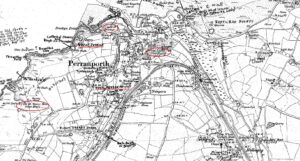
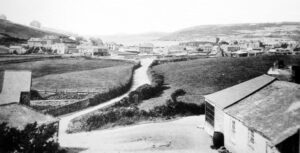
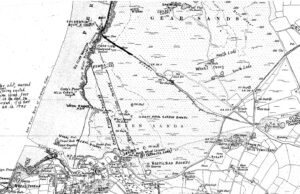
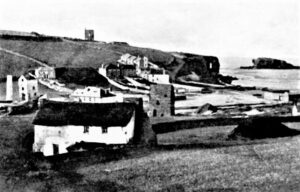
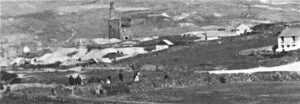
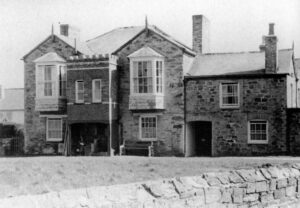
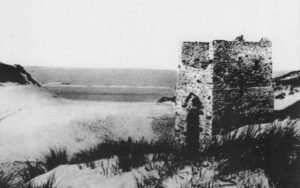
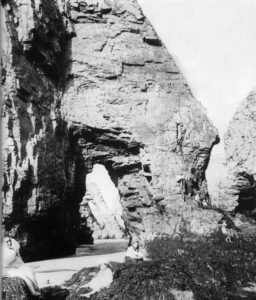
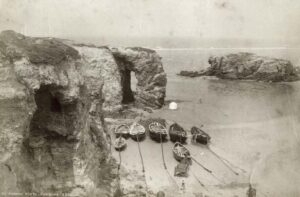
![[34] Voice - Ertach Kernow-170221A - Miners toiled in the wake of St Piran [S] Ertach Kernow - Miners toiled in the wake of St Piran](https://www.cornwallheritage.com/wp-content/uploads/2021/02/34-Voice-Ertach-Kernow-170221A-Miners-toiled-in-the-wake-of-St-Piran-S-231x300.jpg)
![[34] Voice - Ertach Kernow-170221B - Miners toiled in the wake of St Piran [S] Ertach Kernow - Miners toiled in the wake of St Piran](https://www.cornwallheritage.com/wp-content/uploads/2021/02/34-Voice-Ertach-Kernow-170221B-Miners-toiled-in-the-wake-of-St-Piran-S-227x300.jpg)